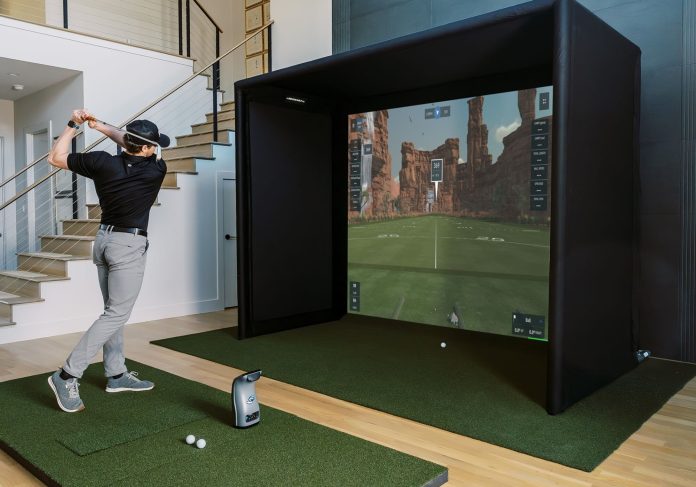There isn’t a golfer on the planet who hasn’t looked at a corner of their house and thought, “You know, I wonder if I could put a golf simulator in there?”
I would bet all of Paul McCartney’s money and most of my money on it.
And I’ll bet what’s left that the next question was, “I wonder how much it would cost?”, followed closely by, “How would I get this past the House Ways and Means Committee?”
We golfers are nothing if not predictable.
The home simulator business was growing even before COVID. However, thanks to the worldwide pandemic, it has been hotter than a Dallas sidewalk in July. Interestingly, it’s an industry that has shifted a bit in focus.

“We’ve sold systems for $10,000 to $15,000,” says Rene Delgado, founder and CEO of Dallas based indoor golf shop. “Since the beginning of the year, we’ve seen customers prioritize value. Technology and accuracy are a close second.”
It is an industry that is changing as fast as technology.
Who buys a home golf simulator?
“We golfers are interesting people,” says Delgado, founder Indoor golf shop in 2017. “We’re very passionate about the game and we’re not afraid to go out and buy a $600 driver. We have this obsession with the game. We want to improve and play golf on our terms.
“And our demographic has the disposable income to feed that addiction.”

Delgado’s journey in the golf industry has been anything but a straight line. Ten years ago, he worked for Beats by Dre, the headphone and electronics company started in 2006 by rapper and record producer Dr. Deer. That May, Apple bought Beats by Dre for $2.4 billion, and Delgado moved to Corporate America.
“Beats was a very nimble, fast-paced company,” says Delgado. “When Apple bought us, I joined Apple and joined their ecosystem. Beats only had a few hundred people. Apple had tens of thousands. My scope of work narrowed considerably.
“Honestly, I was bored.”

A bored entrepreneur doesn’t sit still for long. While trying to think of a new business to start, Delgado decided to buy a launch monitor to fuel his lifelong passion for golf. When he realized it wasn’t as easy as it should have been, the proverbial light bulb went off over his head.
“Everything was so heavy. Launch monitor companies were focused on technology and manufacturing and not so much on marketing and sales.”
Realizing he couldn’t be the only one finding the process difficult, Delgado began Indoor golf shop. The idea was to provide one-stop shopping for home golf simulators in a complete package for DIYers.
Delgado found a niche and underserved market almost immediately. However, this niche will explode in March 2020.

Expansion driven by COVID
Almost everything in golf exploded during COVID, especially the home simulator business.
“Golf was one of the things where people could take shelter,” Delgado explains. “Our growth accelerated by four, maybe five years. We saw hockey stick-type growth in 2020, 2021 and 2022.”
A little perspective is needed here. COVID was only four years ago, but staying at home and buying things online was our reality. Suddenly, buying a full-featured golf simulator for your garage or rec room wasn’t such a crazy idea. Buying a complete package online from a supplier was even better.

“We had some ‘oh, shit’ moments during COVID,” says Delgado. “The biggest one was keeping up with demand. At the time, we weren’t making our own product. We were dependent on other companies and their supply chains.
“That’s when we made a big investment in manufacturing to control our supply chain as much as possible.”
In 2021, Indoor golf shop began the production of a large part of its products.

“We make all of our screens, golf mats, enclosures, wall panels and nets right here in Dallas,” says Delgado. “It allows us to be nimble and it’s been a game changer.”
Staffing challenges
The growth of the “hockey stick” also creates a human capital challenge, especially during a global pandemic. From the outset, Delgado admits to simply throwing healthy bodies at the problem. When the dam is leaking, you’re only looking for your fingers.
“We went ahead with it, but, over time, we realized that some of those people weren’t a good fit for our company, our culture and the values we stand for.”

Once the COVID madness subsided, The Indoor Golf Shop had a corporate reset in 2022.
“Culture is everything to us. I came from Corporate America, and I really don’t like Corporate America. Every morning, the first thing I do is walk around the entire campus and say ‘good morning’ to everyone. If anyone needs anything, we have an open door policy and they can come and talk to me.”
Indoor golf shop has 65 employees. The main office and factory are in Dallas. It has sales and showroom offices in New Jersey and Chicago and an installation and design center in Toronto.

The indoor golf shop and the changing simulator market
The direct-to-consumer residential business currently accounts for about 85 percent of the company’s business.
“Our bread and butter is the complete simulator package that we ship on a pallet,” says Delgado. “The customer receives it in one delivery. It has everything they need and is very easy to assemble.”
The most popular package starts at around $5,000. However, as noted, Delgado has noticed a shift toward more “value-focused” packages. This, of course, is the code for “lower price”.

“The new launch monitor technology opens up more value plays,” he explains. “There’s a lot of macroeconomic stuff going on, so we had to shift and start making new products aimed at that lower-priced market.”
It’s impossible to overstate the impact of the newest wave of budget-minded launch monitors. While you can get the full Foresight QuadMAX for a cool 20, the Garmin Approach R10 and Rapsodo MLM2 PRO both offer simulation packages and cost under $700. Despite those lower-priced options, Delgado says his most popular launch monitors are in the $2,000 to $3,000 range.
“That would be something like the Bushnell LaunchPro ($1,999), SkyTrack Plus ($2,495) or Uneekor EYE MINI Lite ($2,759). Some people want a top boot monitor. They will start in about six months.”

What can you get for, say, $2,000?
“If someone wants to get into a system for about $2,000, they absolutely can,” Delgado says. “It’s just a function of that technology and what kind of configuration they’re going to get.”
For that price, a screen and projector are questionable. You’re probably looking at a simple net (a good one will run up to $400), a good hitting mat (don’t skimp here, plan on around $550), and a Garmin R10 ($599) or a Rapsodo MLM2 PRO ( 699 dollars). You’ll need a phone or tablet and a TV for video and maybe a few other accessories, but that’ll do the trick.

“A budget option is different for everyone,” Delgado explains. “Our best-selling package is the SIG10, with a simulator enclosure and a premium display. It comes with a stand to occupy the space between your screen and your kick mat and your choice of projector.”
or complete SIG10 package with a SkyTrak+ launch monitor starts at about $5,600. A garage package with a less elaborate enclosure starts at $4,800.

An ever-changing industry
While the price-value matrix may be shifting, we’re definitely not talking about “a chicken in every pot” just yet. For those with disposable income, the question is whether such a thing is practical in the space available.
of Indoor golf shop there are exhibitions in all its locations. The simulators are staged to look like they are in a home so that customers can imagine what they would look like in their own home.
“People are starting to see that some of their friends have systems in their homes,” Delgado says. “And now they want theirs.”

You might think that now, with winter coming, would be the busiest time for home simulators. You might also think that the snow belt is the busiest market. You would be wrong on both counts.
“This year sales really started moving in July,” says Delgado. “And California, Texas and Florida are our top three performing markets, with Texas being our number one state.”
This makes sense in an inverted way. As we up north prepare for winter, golfers in California, Texas and Florida are pointing and laughing. Until it drops below 50, that is. That’s when they go home. It’s the same at the end of summer. If you don’t close first thing in the morning, you probably aren’t hitting the links.
“It gets over 100 degrees in a hurry,” Delgado says.

Your turn, Golfspies…
While it is possible to build something, we would like to hear what you think about home golf simulators. Do you have one? How did you put it together? Looking for accurate ball data, or just want to play Pebble Beach from your living room?
Inquiring minds want to know.
Post The indoor golf shop and the evolution of home golf simulators appeared first on MyGolfSpy.


